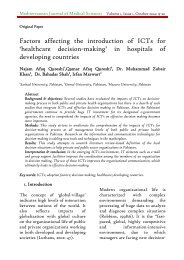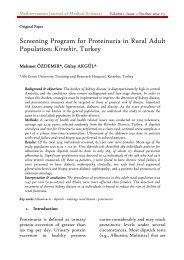Screening Program for Proteinuria in Rural Adult Population: Kirsehir, Turkey
Background & objectives: The burden of kidney disease is disproportionately high in central Anatolia, and the conditions often remain undiagnosed until late-stage disease. In order to reduce this burden, strategies must be implemented to improve the detection of kidney disease, and preventative measures must be targeted at those at greatest risk of disease. Important risk factors among include hypertension, diabetes, and obesity. As the exact prevalence of proteinuria is not known in the general population, we undertook this study to estimate the same in a rural adult population in Kirsehir district. Methods: A survey of health and health related issues was conducted on 2524 volunteers, average age 52.19 years, selected randomly from the Kirsehir District, Turkey. A dipstick urinalysis and test for Proteinuria was performed on a clean void, untimed urine sample as a part of a 4-hour interview/examination. Ultrasound of the abdomen was done in patients with renal failure and renal biopsy was performed in selected patients. Results: Of the total 2524 individuals screened, 61.3 per cent were females. Mean age of the study population was 51.19 ± 11.2 yr. First dipstick test identified 289 individuals positive for albuminuria. Repeat dipstick could be done in only 263, of whom 117 showed persistent albuminuria. Significant proteinuria was detected in 14 individuals of the 208 who had 24 h urine protein measured. Of these 14 patients, 3 were found to have chronic renal failure, 6 were presumed to have diabetic nephropathy clinically, one each had focal segmental glomerulosclerosis and biopsy proven diabetic nephropathy, and 4 patients had proteinuria of unknown aetiology. Interpretation & conclusion: The prevalence of proteinuria in this adult rural population was 0.47 per cent (0.30-0.67%) and Males were more affected than females. The detection and treatment of chronic kidney disease in 14 individuals is bound to reduce the rate of decline of renal functions. Key words: Albuminuria - dipstick - endstage renal disease - proteinuria
Background & objectives: The burden of kidney disease is disproportionately high in central
Anatolia, and the conditions often remain undiagnosed until late-stage disease. In order to
reduce this burden, strategies must be implemented to improve the detection of kidney disease,
and preventative measures must be targeted at those at greatest risk of disease. Important
risk factors among include hypertension, diabetes, and obesity. As the exact prevalence of
proteinuria is not known in the general population, we undertook this study to estimate the
same in a rural adult population in Kirsehir district.
Methods: A survey of health and health related issues was conducted on 2524 volunteers,
average age 52.19 years, selected randomly from the Kirsehir District, Turkey. A dipstick
urinalysis and test for Proteinuria was performed on a clean void, untimed urine sample as a
part of a 4-hour interview/examination. Ultrasound of the abdomen was done in patients
with renal failure and renal biopsy was performed in selected patients.
Results: Of the total 2524 individuals screened, 61.3 per cent were females. Mean age of the
study population was 51.19 ± 11.2 yr. First dipstick test identified 289 individuals positive for
albuminuria. Repeat dipstick could be done in only 263, of whom 117 showed persistent
albuminuria. Significant proteinuria was detected in 14 individuals of the 208 who had 24 h
urine protein measured. Of these 14 patients, 3 were found to have chronic renal failure, 6
were presumed to have diabetic nephropathy clinically, one each had focal segmental
glomerulosclerosis and biopsy proven diabetic nephropathy, and 4 patients had proteinuria of
unknown aetiology.
Interpretation & conclusion: The prevalence of proteinuria in this adult rural population was
0.47 per cent (0.30-0.67%) and Males were more affected than females. The detection and
treatment of chronic kidney disease in 14 individuals is bound to reduce the rate of decline of
renal functions.
Key words: Albuminuria - dipstick - endstage renal disease - proteinuria
You also want an ePaper? Increase the reach of your titles
YUMPU automatically turns print PDFs into web optimized ePapers that Google loves.
Mediterranean Journal of Medical Sciences V1, I1 October 2014: 1-5 2<br />
positive <strong>for</strong> prote<strong>in</strong> are a result of<br />
benign prote<strong>in</strong>uria, which has no<br />
associated morbidity or<br />
mortality[5] . Among the various<br />
predictors of progression of<br />
chronic kidney disease to end<br />
stage renal disease (ESRD),<br />
prote<strong>in</strong>uria is the most potent<br />
predictor[6]. Angiotens<strong>in</strong><br />
convert<strong>in</strong>g enzyme (ACE)<br />
<strong>in</strong>hibitors (ACEi) and angiotens<strong>in</strong><br />
II receptor blockers (ARB) have<br />
been given to persons with<br />
prote<strong>in</strong>uria and chronic kidney<br />
disease to decrease the progression<br />
to end stage renal disease[4,7-11],<br />
treatment of prote<strong>in</strong>uric patients<br />
with ACEi and ARB has been<br />
shown to decrease the rate of<br />
progression of chronic kidney<br />
disease.<br />
S<strong>in</strong>ce the exact prevalence and<br />
cause of prote<strong>in</strong>uria as a marker of<br />
kidney disease is not known <strong>in</strong><br />
our population, we undertook this<br />
study to estimate the same <strong>in</strong> a<br />
rural population <strong>in</strong> <strong>Kirsehir</strong>.<br />
2. Material & Methods<br />
A convenient sample of 2524<br />
adults (aged 40 yr and above)<br />
from rural area of <strong>Kirsehir</strong>, <strong>Turkey</strong><br />
was <strong>in</strong>cluded <strong>in</strong> the study. The<br />
study was carried out <strong>for</strong> a period<br />
of 24 months between April 2011<br />
and April 2013. Individuals were<br />
selected under an ongo<strong>in</strong>g<br />
community health programme by<br />
the Department of Urology, Ahi<br />
Evran University Tra<strong>in</strong><strong>in</strong>g and<br />
Research Hospital, <strong>Kirsehir</strong>,<br />
<strong>Turkey</strong>.<br />
After expla<strong>in</strong><strong>in</strong>g about the<br />
objective of the study, <strong>in</strong>dividuals<br />
were tested <strong>for</strong> album<strong>in</strong>uria by<br />
dipstick exam<strong>in</strong>ation (Multistix<br />
SG, Bayer Diagnostics) <strong>in</strong> an<br />
untimed ur<strong>in</strong>e sample. Individuals<br />
who had acute illness, non<br />
ambulatory persons and<br />
menstruat<strong>in</strong>g women were<br />
excluded. Individuals tested<br />
positive <strong>for</strong> album<strong>in</strong>uria<br />
underwent a second dipstick<br />
exam<strong>in</strong>ation after a gap of one<br />
week. Repeat dipstick was<br />
per<strong>for</strong>med to rule out transient<br />
prote<strong>in</strong>uria.<br />
Individuals with persistent<br />
album<strong>in</strong>uria on the second<br />
dipstick exam<strong>in</strong>ation underwent<br />
further evaluation at the which<br />
<strong>in</strong>cluded medical history, physical<br />
exam<strong>in</strong>ation, 24 h ur<strong>in</strong>e prote<strong>in</strong><br />
estimation, total serum prote<strong>in</strong><br />
and album<strong>in</strong> estimation. Those<br />
who had prote<strong>in</strong>uria (prote<strong>in</strong><br />
excretion >150 mg/day on 24 h<br />
ur<strong>in</strong>e prote<strong>in</strong> estimation)<br />
underwent ur<strong>in</strong>e microscopic<br />
exam<strong>in</strong>ation, blood urea and<br />
serum creat<strong>in</strong><strong>in</strong>e, fast<strong>in</strong>g and<br />
postprandial blood sugar level<br />
estimations. Ultrasound of the<br />
abdomen was done <strong>in</strong> patients<br />
with renal failure (serum<br />
creat<strong>in</strong><strong>in</strong>e >1.4 mg/dl). Renal<br />
biopsy was per<strong>for</strong>med <strong>in</strong> patients<br />
with prote<strong>in</strong>uria >1 g/day or<br />
©2014 Mediterranean Center of Medical Sciences








